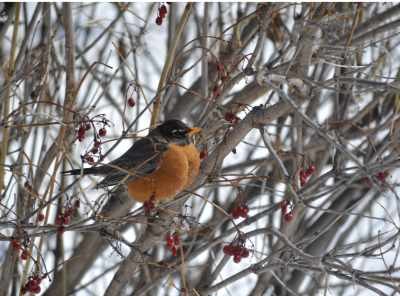The first flock of robins arrived just days before 20 cm. of heavy wet snowfall covered everything, on Wednesday, April 1; with -24-degree nighttime temperature on Friday/Saturday. I love robins and I wondered, how would they survive?
A walk down the street reassured us that they would. Bird feeders abound on our street; trees with last fall’s fruit still attached were being ravaged. Robins don’t worry about finding earthworms just yet.
The robin is an inspiring, heart-warming bird for me.
Years ago, confined to a hospital room for the birth of our third child, I watched a pair of robins raising their chicks.
Their busy family life served as not only a distraction, but, actually an inspiration to me.
After my own birthing process, I watched the pair of robins with great interest.
The deeply orange breasted male robin was looking fairly rumpled, his feathers were askew. Was he a first-time father? Or was he an experienced bird?
He worked really hard.
Both parent birds were back and forth to the nest bringing beakfuls of bugs to the fledglings. The chicks’ open mouths were barely visible above the edge of the nest.
This bird family’s daily work paralleled our time of life, working to raise our young family.
Out of admiration for these birds, we named our son Robin, as if the industrious, faithful attributes of the father robin right outside my hospital room window was a foreshadowing of the child we would raise.
Years later, I can say it was.
For birders
Did you know there is a website devoted to bird stories? www.wild-bird-watching.com/Bird-Stories.html
You can read about a robin that nested on a ceiling fan in someone’s porch, and many more vignettes. Delve into the habits and idiosyncrasies of these feathered friends.
American Robin:
- Robins can produce up to three successful broods per year.
- On average, two clutches are raised with less than half being successful.
- Only a quarter of those that do fledge survive to November.
- About half of the birds alive in any year will make it to the next.
- The whole population turns over on average every six years. (Cornell Lab of Ornithology)
The female lays 3-7 light blue eggs that are incubated for 12-14 days; young leave the nest in about 14-16 days.
Robins eat different types of food depending not only on the time of year, but even time of day. They eat earthworms early in the day and more fruit later in the day.
Because they forage largely on lawns, they are vulnerable to pesticide poisoning and can be an important indicator of chemical pollution.
The American Robin typically winters throughout the USA, as far north as North Dakota. Their breeding grounds range throughout Canada.




